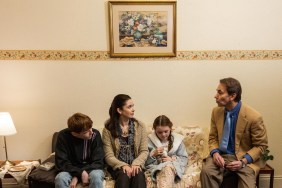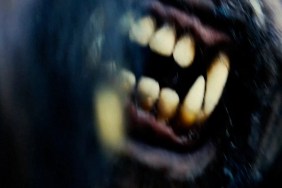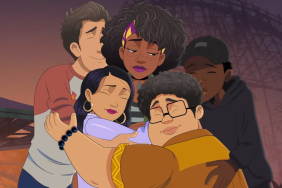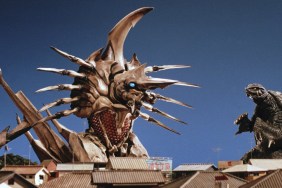Opening Friday, January 18th

Cast:
Michael Stahl-David as Rob Hawkins
Mike Vogel as Jason Hawkins
Jessica Lucas as Lily Ford
T.J. Miller as Hud Platt
Lizzy Caplan as Marlena Diamond
Odette Yustman as Beth McIntyre
Directed by Matt Reeves
Review:
The resounding box office success of “Cloverfield” begs the question: if you were to take such choice Sci-Fi Channel creature features as “Ice Spiders,” “Deep Shock” and “Basilisk: The Serpent King,” give them non-descript titles, keep their CGI beasts under wraps, and give them viral marketing campaigns, would you have a steady stream of blockbusters on your hands?
Unfortunately for the Sci-Fi Channel’s talent pool, the answer is “probably not,” but if nothing else, “Cloverfield” is proof that it’s often not about the movie that you’ve made; it’s about the movie that you’re selling.
As everyone in the movie-going world knows by now, the J.J. Abrams-produced “Cloverfield” is the latest entry in the “found” footage sub-genre. The most famous standard-setter in this cinematic category may be “The Blair Witch Project” (1999) but these types of films have been around since at least as far back as 1980’s “Cannibal Holocaust” and with today’s increased access to recording devices, it only makes sense for filmmakers to utilize the amateur perspective more (George Romero’s “Diary of the Dead” and the faux serial killer saga “The Poughkeepsie Tapes” are also due this year). So it was inevitable that sooner or later someone would take the opportunity to stage this type of monster movie.
But if this hand held approach is about achieving verisimilitude, then “Cloverfield” fails (sorry, no grading on a curve here). One of the strengths of “Blair Witch” was that everything that we saw through the camera lens really happened (well, in the sense that no movie trickery could be detected â they didn’t digitally insert weird lights in the woods, for instance). Hell, the makers of “Cannibal Holocaust” were so committed to realism that they killed a real sea turtle right on camera! That’s not approvable behavior but still, point made. So how do you pull off a monster movie with this approach?
Granted, this is a different situation than either “Blair Witch” or “Cannibal Holocaust” in that we know that Manhattan hasn’t really been stomped to shit by any monsters so the prospect of “convincing” an audience can’t be the same. But yet if people are going to complain that the CGI of “I Am Legend” spoiled that film for them, then “Cloverfield” should have just as much to answer for. I can accept CGI in movies â at times I don’t even mind seeing CG that’s on the sketchy side. But not here. As soon as I saw the first glimpse of this creature’s computer-generated backside, I could only think: why bother? Why bother making a movie whose main selling point is depicting the ground level perspective of a monster attack if the monster is just going to be another reject from a video game?
Watching “Cloverfield’s events play out through jittery footage long after the film has revealed that its creature is not going to convincingly gel with its surroundings is just obnoxious. If his monster was going to look this phony, director Matt Reeves might just as well have abandoned the hand held approach mid-film and switched to a conventional movie. Or if it’s all going to look fake anyway, the inclusion of a stop motion shot or two or a guy in a monster suit would’ve at least endeared this film to me.
No matter how much the camera shakes, no matter how strategically placed the glimpses of the monster are inserted (shots that only serve the opposite effect of calling attention to the film’s artifice), at no time during “Cloverfield” did I ever think that its creature was sharing the same space with anything else on the screen and that’s unforgivable when “Jurassic Park” (1993) established fifteen years ago (!) just how seamless that kind of interaction can be. How can “Cloverfield” set a new standard in monster movies when it isn’t even up to par with the old standard?
Ironically, another Steven Spielberg film â 2005’s “War of the Worlds” â is also a better example of the kind of realism that “Cloverfield” is chasing after with Spielberg expertly adapting the shaky, hand held immediacy he brought to “Saving Private Ryan” (1998) to tell H.G. Wells’ tale of ordinary people on the run from an alien invasion. With “War of the Worlds,” Spielberg made me believe that Martian tri-pods were laying waste to everyday America far more than Reeves was able to convince me of a monster being on the loose in Manhattan.
With its monster being a wash out, there’s only “Cloverfield’s human characters left to fall back on and that’s a dead end deal, thanks to Drew Goddard’s script. If you think that following a pack of unlikable, self-absorbed douchebags makes for a good time then, man, you’ve just hit paydirt. For anyone else, let the teeth grinding begin. The film’s principal cameraman, Hud (T.J. Miller), is a vacant imbecile. That’s not just my personal impression of him â that’s exactly how he’s portrayed. That’s his character.
Then there’s Rob (Michael Stahl-David), Hud’s successful bud (you’ll never forget his name thanks to Hud endlessly calling after him: “Rob! Rob! Rob! Rob!”) who’s meant to leave for Japan the next day for his upscale new job. Goddard’s script sends Rob on a journey into the heart of the city (now Monster Central) with his friends in tow to find a girl he loves but whom he had pushed away earlier before the shit hit the fan (oh, the drama!). But his drive to get to this girl never comes off as anything other than a nitwit’s quest (an impression only abetted by insipid flashbacks interjected throughout the film to a happy day that Rob and his dream girl spent together a month earlier).
If Goddard’s script had depicted a parent trying to get back to their child, or someone trying to get back to their spouse or an ailing parent or a pregnant girlfriend or wife â then it’d be easy to see why it’s so important to for someone to risk their life as well as the lives of their friends to get to this person. But the unsexy real world baggage those scenarios carry would likely scare “Cloverfield’s target audience more than any monster could. Much better to have it be about a girl your main character, uh, kind of likes and who they might be thinking about maybe getting serious with. That’s the best reason ever to enter an apartment building that’s about to fall onto the street.
I wish that there had been no narrative at all in “Cloverfield,” that the camera would’ve been passed along from one unrelated person to another â or that the film had been assembled from the footage of multiple “found” cameras. That might’ve made for an interesting film. If nothing else, it would saved us from having to care solely about the plight of these doofus urban professionals. And while some would argue that the characters of “Blair Witch” were also annoying, I disagree. At least the characters in Blair Witch brought genuine reactions to their plight. The unvarnished displays of fear, anger and remorse that those characters portrayed made them relatably human whereas the characters in “Cloverfield” never seem any more real than the CGI monster that’s stalking them.
The potential upside to “Cloverfield’s success is that it might give other creature-orientated projects a better shot at being made (which earns it a review point, the other point is from its mercifully brief running time). The downside is that the most likely of those projects will be “Cloverfield 2.”










